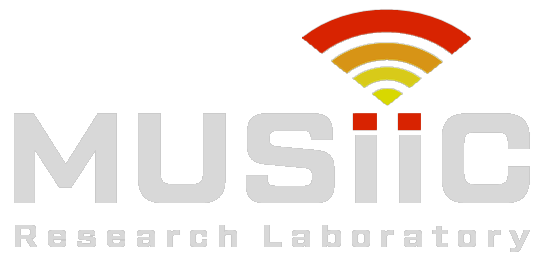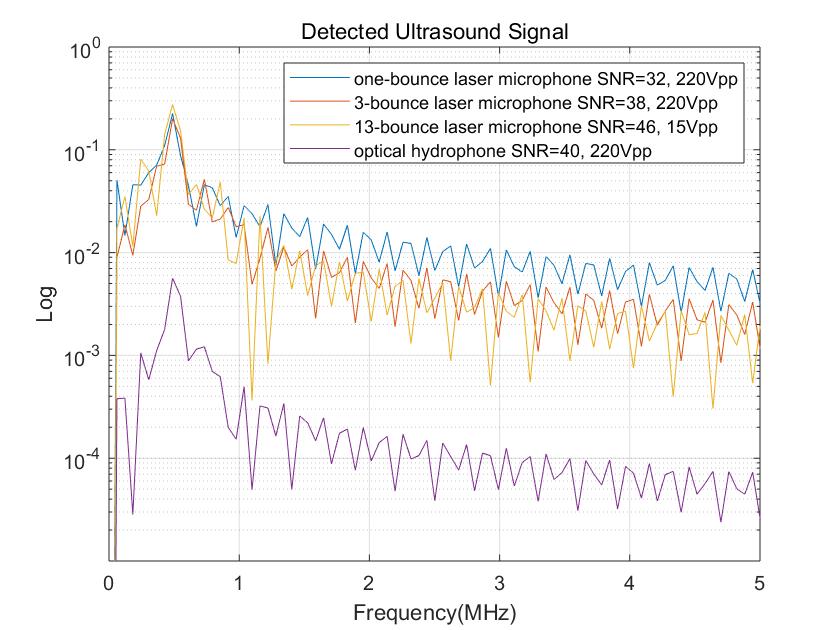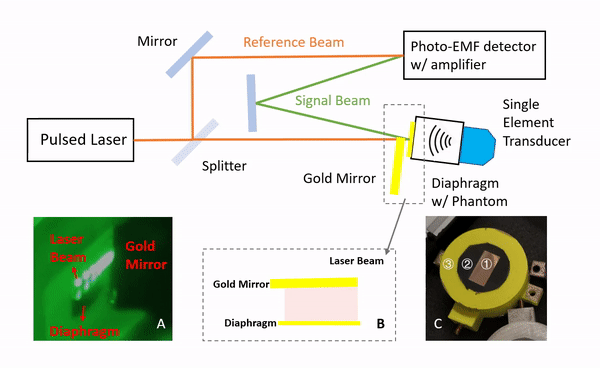For clinical diagnosis and surgical monitoring and guidance, many imaging modalities are able to non-invasively show regional anatomy and position details, but few of them are able to provide functional information. Monitoring the concentration of metabolism-related species or bio-markers could also be helpful during surgery and in interventional imaging. For example, to determine whether the tissue in a specific anatomic location is injured, dead or healthy, more detailed physiological information is required. This may include but not be limited to metrics of blood circulation such as blood flow, oxygen saturation (sO2), carbon dioxide (pCO2) and other in vivo indices. Photoacoustic imaging represents a potential solution for both structural and functional imaging. Currently, challenges to application of photoacoustic imaging fall broadly into two area: 1) the sensitivity of detection provided by the transducers and 2) safety concerns due to laser hazards. With the ultra-sensitive detection method, even when the photoacoustic signal was generated by relatively weaker illumination power to reduce laser exposure dose for the imaging target, it can still be sensed.
The multi-bounce laser microphone utilizes optical methods to detect the displacement of a gold-covered thin film diaphragm caused by ultrasound signal pressure waves. This sensitive all-optical sensing technique provides new opportunities for advanced ultrasound and photoacoustic imaging as it is expected to achieve a higher detection signal-to-noise ratio (SNR) in a broader spectrum, as compared to conventional ultrasonic transducers. The technique does not involve signal time-averaging and the real-time enhancement in detection SNR stems from the amplification of signal strength due to multiple bouncing off the diaphragm. The system was previously developed for detecting acoustic signatures generated by explosives and were limited to lower than 10 kHz in
frequency. To demonstrate its feasibility for biomedical imaging applications, preliminary experiments were conducted to show detection of ultrasound waves with frequencies ranging from 100 kHz to in excess of 1 MHz.
Experimental results have demonstrated the improved sensitivity of the multi-bounce laser microphone in detecting ultrasound signals when compared with a commercial Fabry-Perot type optical hydrophone. And, the multi-bounce laser microphone has also been applied in detecting photoacoustic signatures emitted by India ink when a LED bar is used as the excitation source.
Publications
Q. Wan et al., “Ultrasound Signal Detection with Multi-bounce Laser Microphone,” 2020 IEEE International Ultrasonics Symposium (IUS), Las Vegas, NV, USA, 2020, pp. 1-4, doi: 10.1109/IUS46767.2020.9251499.
Team members
Qianqian Wan, Keshuai Xu, Yixuan Wu, Jeeun Kang
ChenChia Wang, Sudhir Trivedi, Peter Gehlbach
Acknowledgment
Supported by National Institutes of Health through the grant 1R43HD102260-01. Research to Prevent Blindness, New York, New York, USA, and gifts by the J. Willard and Alice S. Marriott Foundation, the Gale Trust, Mr. Herb Ehlers, Mr. Bill Wilbur, Mr. and Mrs. Rajandre Shaw, Ms. Helen Nassif, Ms Mary Ellen Keck, Don and Maggie Feiner, Dick and Gretchen Nielsen, and Mr. Ronald Stiff.
We also thank Dr. Ernie Graham for his support in this work.


